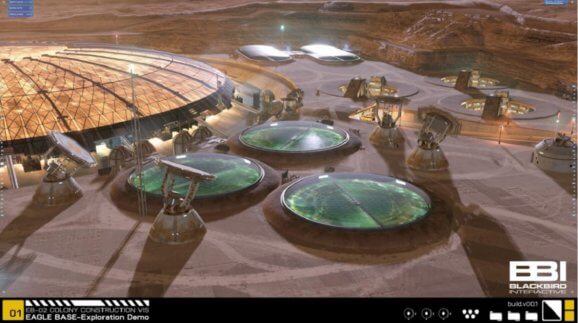
It isn’t easy to marshal the will to create a human colony on Mars. It’s an expensive project, and to pull it off, you need a vision. To build that vision, a scientist at National Aeronautics and Space Administration (NASA) turned to a video game company.
Blackbird Interactive, a Canadian game developer, has built an interactive art demo that illustrates its own vision for a human settlement on Mars. It unveiled the demo, dubbed Project Eagle, at the DICE Summit, the elite game event in Las Vegas this week.
It is the brainchild of Jeff Norris, founder and director of the Mission Operations Innovation Office at NASA’s Jet Propulsion Laboratory. He and Blackbird studied the work of the original moon exploration advocates of the 1950s. The proselytizers of that time included Chesley Bonestell and Wernher von Braun. Von Braun created the technology and the arguments for a human expedition to the moon and beyond, while Bonestell created the images, like what the view of Saturn would look like from Titan.

Above: Creators of Project Eagle at DICE Summit.
“This was the birth of space art,” Norris said. “It was equal parts art and science.”
Their goal, like NASA’s goal today, was to to use art to bring science and space exploration into the hearts and minds of the public, and to show that dreams of colonizing other planets are possible within the next few decades rather than the next few centuries.
“There is an enormous opportunity of filling this great void in the industry today,” Norris said. “What would Chesley Bonestell’s work be today, if you produced it today with games?”
The result is Project Eagle, an interactive model of a Mars colony in Gale Crater at the base of Mount Sharp, near the original landing site of the Mars Curiosity Rover. It was created using terrain data from the HiRise camera aboard the Mars Reconnaissance Orbiter, and designed with input from NASA scientists about the technological and material constraints and possibilities for building human habitation on the red planet.

Above: Project Eagle, created by NASA and Blackbird Interactive.
“Games can be achingly beautiful like this (Ori and the Blind Forest). They can make us laugh. They can occasionally make us cry,” Norris said. “Some of you need to step it up a little bit. Great art does not just move us as individuals. It can move entire societies.”
Back in January 2017, Norris reached out to Vancouver-based Blackbird to collaborate with the U.S. space agency on Project Eagle, the name for what a human settlement on Mars would look like. Project Eagle is set in 2117, 44 Martian years (82.8 Earth years) after first human mission to Mars. The company volunteered its time to work on the project.
Norris showed off the demo at the DICE Summit, the elite game industry event in Las Vegas this week. Blackbird CEO Rob Cunningham and Aaron Kambeitz, chief creative officer, joined Norris on stage. A spokesperson for NASA said the demo was created for the DICE Summit event and it was not considered an official rendering of NASA’s vision for a Mars base. Rather, it was Blackbird’s own vision for a settlement based on input from NASA scientists.

Above: Vehicles that could exist on Mars.
They started using the engine for their own space combat game, Homeworld: Deserts of Kharak, to build the art for the colony. They created things like algae ponds, perchlorate piles, sulfur piles, greenhouses, and solar arrays — all with consultation from NASA engineers. The vision is to create Project Eagle in a hundred years, with nearly 6,000 people living on it.
Here’s a video of Project Eagle.
[Story updated 2/25/17 with info from NASA].
Source: Blackbird Interactive builds vision of what a Mars base would look like




